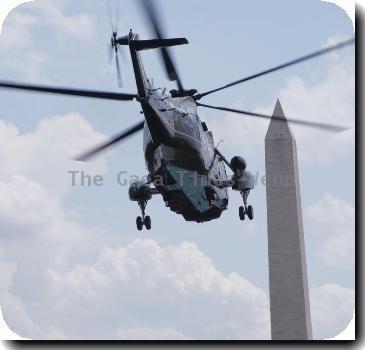Some oil spill events from Thursday, July 15, 2010
By APThursday, July 15, 2010
Some oil spill events on Thursday, July 15, 2010
A summary of events Thursday, July 15, Day 86 of the Gulf of Mexico oil spill that began with the April 20 explosion and fire on the drilling rig Deepwater Horizon, owned by Transocean Ltd. and leased by BP PLC, which is in charge of cleanup and containment. The blast killed 11 workers. Since then, oil has been pouring into the Gulf from a blown-out undersea well, though BP said it finally choked off the flow Thursday afternoon.
OIL OFF
BP finally choked off the flow of oil into the Gulf of Mexico on Thursday, 85 days and up to 184 million gallons after the crisis unfolded. Then began a tense 48 hours of watching to see whether the capped-off well would hold or blow a new leak. The big, billowing brown cloud of crude at the bottom of the sea disappeared from the underwater video feed for the first time since the disaster began in April, as BP closed the last of three openings in the 75-ton cap lowered onto the well earlier this week.
NO VICTORY DECLARATION
The company stopped far short of declaring victory over the biggest offshore oil spill in U.S. history and one of the nation’s worst environmental disasters, a catastrophe that has killed wildlife and threatened the livelihoods of fishermen, restaurateurs, and oil industry workers from Texas to Florida.
REACTIONS
The news elicited joy mixed with skepticism from wary Gulf Coast residents following months of false starts, setbacks and failed attempts. Alabama Gov. Bob Riley’s face lit up when he heard the oil flow had stopped. “That’s great. I think a lot of prayers were answered today,” he said. President Barack Obama called it a positive sign, but cautioned: “We’re still in the testing phase.” Stephon LaFrance, an oysterman in Louisiana’s oil-stained Plaquemines Parish who has been out of work for weeks, called it a lie. “I don’t believe they stopped that leak. BP’s trying to make their self look good,” he said.
WAIT AND SEE
Then a waiting period began. Engineers will monitor pressure gauges and watch for signs of leaks elsewhere in the well. The biggest risk: Pressure from the oil gushing out of the ground could fracture the well and make the leak even worse. High pressure is good because it shows there’s only a single leak. Lower pressure could mean more leaks farther down in the well. BP expects to keep the oil trapped in the cap for 48 hours before it decides if the approach is working.
BY THE NUMBERS
The stoppage came 85 days, 16 hours and 25 minutes after the first report of the Deepwater Horizon explosion. Somewhere between 94 million and 184 million gallons have spilled into the Gulf, according to government estimates. BP said the oil stopped flowing into the water at 2:25 p.m. CDT after engineers gradually dialed down the amount of crude escaping through the last of three valves in the cap.
CLAIMS
The $20 billion that BP has set aside to pay for losses caused by the spill will start making payments in early August. Ken Feinberg, who is in charge of paying individuals and businesses for lost income, told government officials in Louisiana on Thursday that he expected a seamless transition from BP management to his. BP has 35 offices in the Gulf Coast area accepting claims.
DISPERSANTS
BP’s use of chemicals to disperse the oil has come under renewed scrutiny. The company has used at least 1.8 million gallons of dispersants on the Gulf’s surface and 5,000 feet deep at the source of the leak. Earthjustice has filed a federal lawsuit in Florida to force the Environmental Protection Agency to turn over safety studies on the chemicals. BP says the chemicals have kept much of the spill from reaching the Gulf coast.
MAJOR NESTING AREA
Biologists say oil has smeared at least 300 to 400 pelicans and hundreds of terns in the largest seabird nesting area along the Louisiana coast, a sharp escalation in wildlife harmed by BP’s Gulf of Mexico oil spill. The finding underscores that official tallies of birds affected by the spill could be significantly underestimating the scope of damage. The government counts only oiled birds collected for rehabilitation or found dead. Oiled birds in the many nesting areas that dot the Gulf coast typically are left in place and not counted in official tallies.
INVESTIGATION
A government investigation of the deadly explosion on the Deepwater Horizon oil rig is to resume next week. The Coast Guard and Bureau of Ocean Energy Management, Regulation and Enforcement have scheduled five more days of hearings, from July 19-23, in a New Orleans suburb. A panel of officials from each agency heard six days of testimony in May from rig workers, company executives, government regulators and others. A witness list for next week’s hearings wasn’t immediately released.
OFFSHORE DRILLING AGENCY
A House panel approved legislation Thursday to overhaul the government agency responsible for regulating offshore drilling. The bill would divide the agency into three parts: one for leasing and permitting; another for inspections and investigations; and a third to collect revenue.
SAVING TURTLES
The first group of sea turtles that are part of a sweeping effort to save threatened and endangered hatchlings from death in the oily Gulf of Mexico have been released into the Atlantic Ocean. Fifty-six endangered Kemp’s ridley turtles were released on a beach at Florida’s Canaveral National Seashore this week, the Florida Fish and Wildlife Conservation Commission said Thursday.
Tags: Accidents, Animals, Barack Obama, Birds, Coastlines And Beaches, Energy, Environmental Concerns, Florida, Government Regulations, Louisiana, North America, Oil spill, United States, Wildlife

